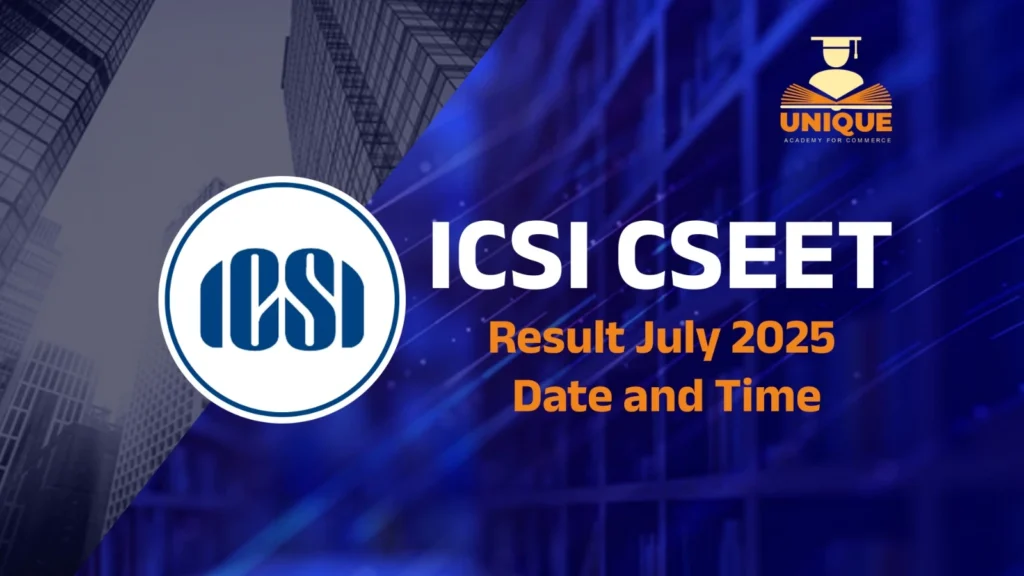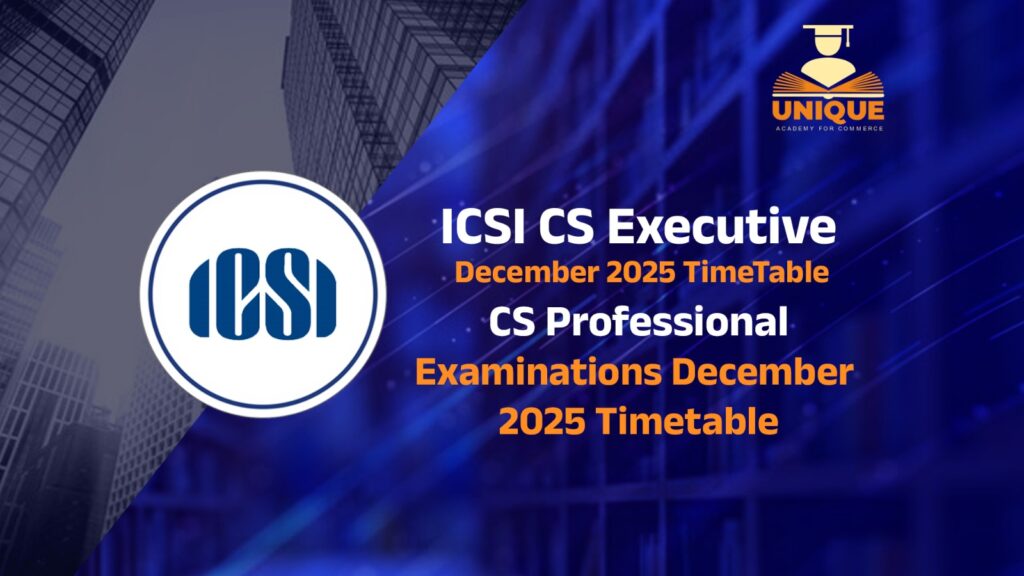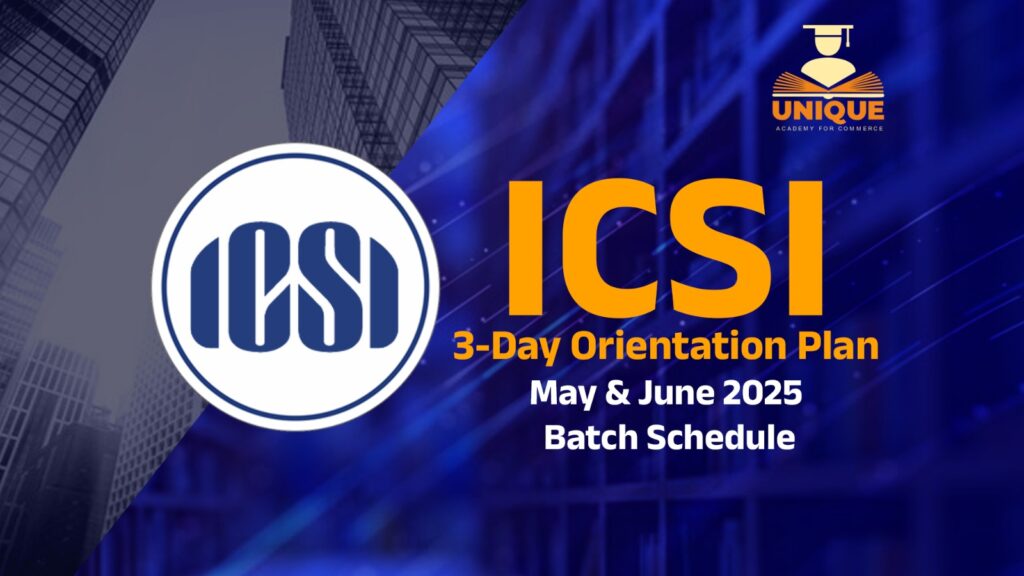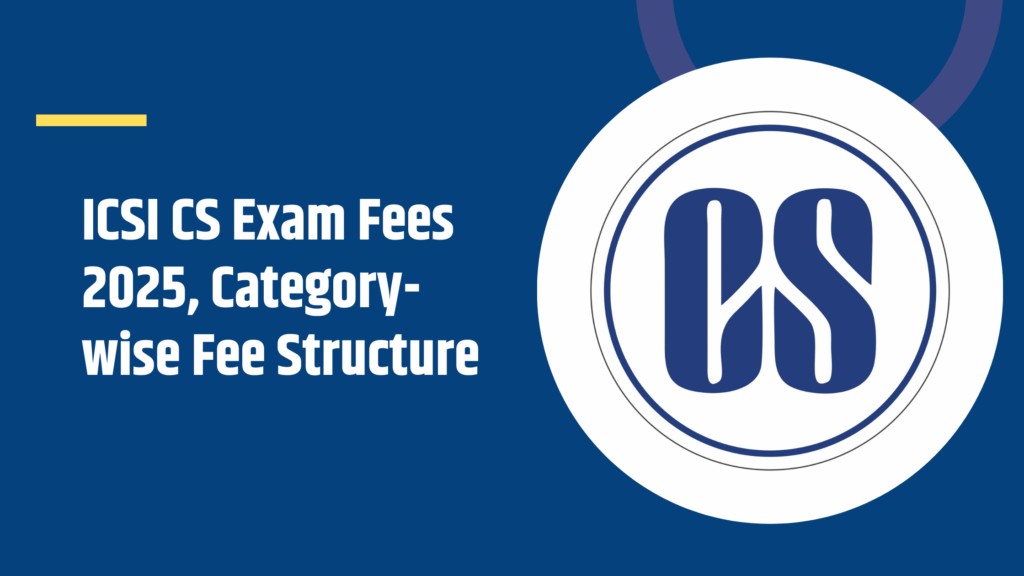How to Prepare CS Executive Corporate & Management Accounting Exam
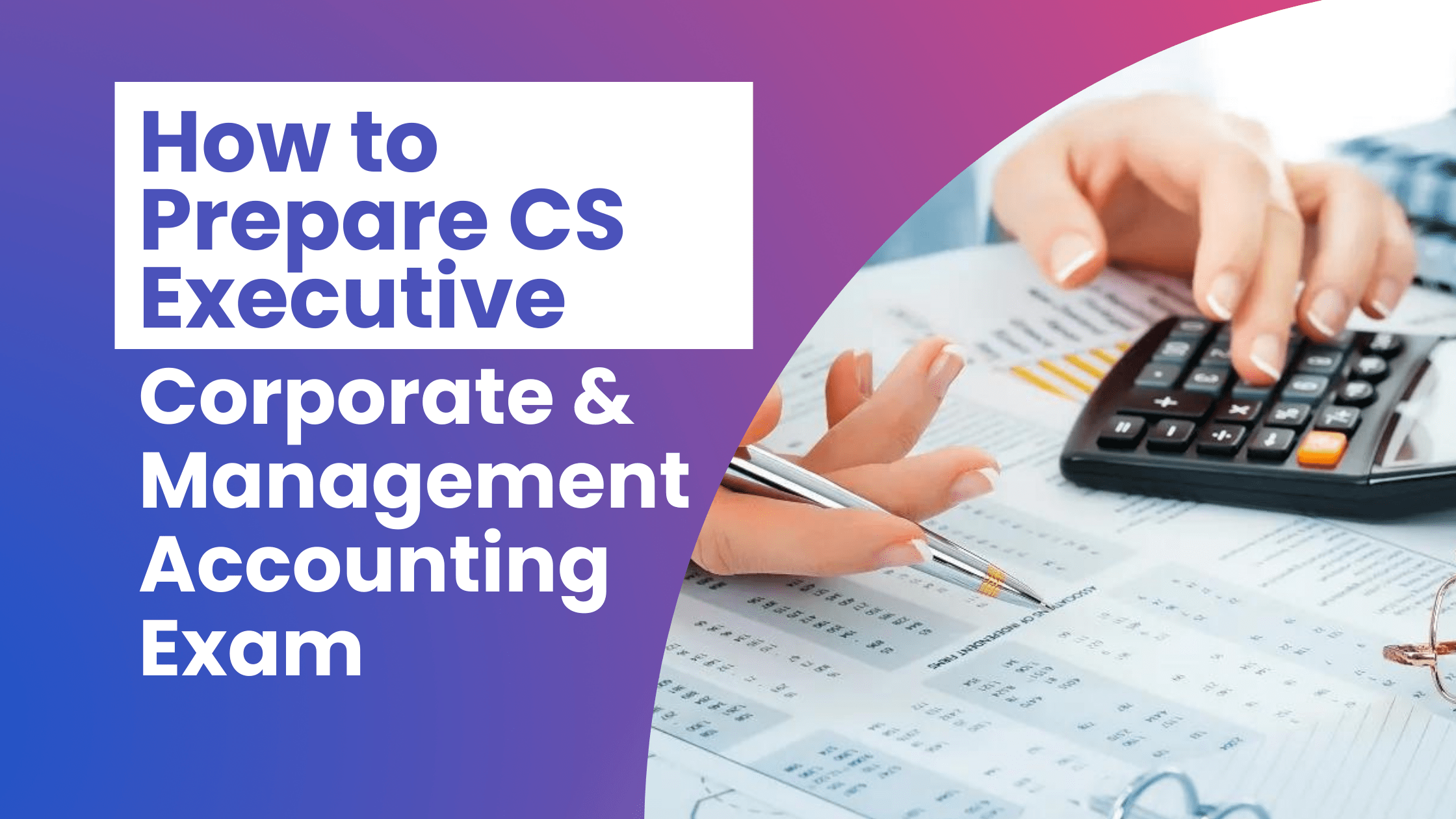
While preparing for CS Examinations, the students are made familiarised with the basics of Cost and Management Accounting concepts. But at the intermediate stage i.e. at the executive stage this subject is introduced for making students aware of the various principles of corporate framework and management techniques.
Knowledge of basics of corporate management is not only important for the CS students for clearing the examination but also it is important from the perspective of understanding the practical implications also.
No doubt that the main role of the Company Secretary is to act as a Compliance Officer of the company. Considering all the importance which this subject holds for any professional student, this subject becomes one of the most important subject of CS Executive examination.
It is the fifth subject of the Module 2 of CS Executive. As we know that CS Executive is the second stage of the professional course of Company Secretary. The executive stage is basically designed to inculcate skills and competence of executive program passed students.
The reason for inclusion of this important subject in the curriculum is to impart practical understanding of these important financial concepts to the students regarding provisions and applicability of costing principles dealing with the various business entities during course of business as well as the corresponding effect on the economy of the country.
An outline of Company Secretary Courses and Specialisation- Executive Programme Papers
There are 8 papers divided into 2 Modules in CS Executive Programme (wef. 01.03.2018)
| Executive Programme [8papers] ( New Syllabus – w.e.f. 1st Mar 2018 ) |
MODULE 1 (4papers) 1. Jurisprudence, Interpretation & General Laws 2. Company Law 3. Setting Up Of Business Entities And Closure 4. Tax Laws MODULE 2 (4 papers) 5. Corporate & Management Accounting 6.Securities Laws & Capital Markets 7.Economic, Business And Commercial Laws 8. Financial And Strategic Management |
An Overview of the subject
The subject is divided into two parts. Part I of the subject deals with the concepts of Corporate Accounting, Part II deals with Management Accounting and Valuation.
ICSI CS Executive New Syllabus Study Material : Module II
| Paper | Coverage |
| Corporate and Management Accounting | Part I : To provide knowledge and understanding of the concepts, principles and practices in Corporate Accounting and Indian and International Accounting Standards. Part II: To acquire knowledge and understanding of the concepts, techniques and practices of management accounting and to develop skills for decision-making and to acquire knowledge of the concepts, principles and methods of valuation. |
CS Executive Examination Syllabus of this subject
Before planning the study curriculum, first of all we should know the contents of the subject. Following is the arrangement Of Study Lessons in this subject
| Module-II Paper- 5Corporate and Management Accounting | 1. Introduction to Financial Accounting 2. Introduction to Corporate Accounting 3. Accounting for Share Capital 4. Accounting for Debentures 5. Related Aspects of Company Accounts 6. Financial Statements Interpretation 7. Consolidation of Accounts as per Companies Act, 2013 8. Corporate Financial Reporting 9. Cash Flow Statements 10. Accounting Standards (AS) 11. National And International Accounting Authorities 12. Adoption, Convergence and Interpretation of International Financial Reporting Standards (IFRS) and Accounting Standards In India. |
| Study Lessons Part II – Management Accounting and Valuation (40 Marks) | |
| 13. An Overview of Cost 14. Cost Accounting Records & Cost Audit Under Companies Act, 2013 15. Budget, Budgeting and Budgetary Control 16. Ratio Analysis 17. Management Reporting (Management Information Systems) 18. Decision-Making Tools 19. Valuation Principles & Framework 20. Valuation of Shares, Business And Intangible Assets 21. Accounting for Share-Based Payments (Ind AS 102) 22. Methods of Valuation |
Strategy for Preparation
The subject of Corporate and Management Accounting is inherently complicated and is subjected to constant refinement through new corporate developments and strategies.
It, therefore becomes necessary for every student to constantly update himself with the various new developments especially w.r.t. SEBI regulations wherein rules and regulations are made for corporate working. Also students can refer to the Institute’s journal ‘Chartered Secretary’ and e-bulletin as well as other law/professional journals.
- Understanding the fundamentals of the subject-First of all the students should understand the basic provisions of the all the respective acts, rules & regulations of the subject.
- Understanding the requirements of the subject-First of all the students should understand the requirement of the paper and subject thoroughly. They should understand the role and responsibilities of the company Secretary while dealing with all the various types of situations mentioned
- Analytical Skills required- It is important for the students to concentrate more on analytical skills rather theoretical concepts. The concepts and applications should be thoroughly understood and be related to the practical business problems.
- Referring recent case studies as posted on the website of the SEBI-While preparing for the examination, the student is required to refer relevant and important recent examples from current affairs happening in and around business.
- Regular Updation- Update yourself about all the relevant circulars, clarifications, notifications, etc. issued by the MCA, SEBI, Judicial pronouncements, provisions etc on or before six months prior to the date of the respective examinations.
- Fundamental topics of subject-Last but not the least, the students need to be aware of the fundamentals and key provisions, amendments to the Acts, Powers, features, and functions of the provisions of the acts, especially before the examination.
Before reading further check out these posts:
Now we will make a framework for studying and preparing this subject, chapter wise.
| Important topics to be covered | |
| Chapter 1 INTRODUCTION TO FINANCIAL ACCOUNTING | Introduction Definition of Accounting Objectives of Accounting Function of Accounting Book-Keeping Accounting Cycle Steps/Phases of Accounting Cycle Basic Accounting Terms Single Entry System Double Entry System Genesis Features of Double Entry System Advantages of Double Entry System Limitations of Double Entry System The Concepts of ‘Account’, ‘Debit’ and ‘Credit’ The Concept of Account Types of Accounts The Accounting Process Books of Prime Entry Functions of Journal Advantages of Journal Explanation of Journal Sub-division of Journals Importance of Sub-division of Journal Compound Journal Subsidiary Books Recording of Cash and Bank Transactions Types of Cash Book Purchase Day Book Sales Day Book Other Subsidiary Books – Returns Inward, Return Outward, Bills Receivable, Bills Payable Journal Proper Ledger Accounts Ledger Posting Posting to Ledger Accounts from Subsidiary Books Typical Ledger Account Balances Closing Balance and Opening Balance Sub-divisions of Ledger Advantages of sub-division of Ledger: Trial Balance Features of a Trial Balance Preparation of Trial Balance Purpose of a Trial Balance Forms of a Trial Balance Method of Preparation Trial Balance – Utility and Interpretation |
| Chapter 2 INTRODUCTION TO CORPORATE ACCOUNTING | Introduction Preparation and Presentation of Financial Statements Schedule III of the Companies Act, 2013 General Instructions for the preparation of Balance Sheet and Profit and Loss Account Presentation of Balance Sheet Part-I – Form of Balance Sheet Disclosure Requirement: Schedules Forming Part of Financial Statements Part II-Form of Statement of Profit and Loss General Instructions for preparation of Statement of Profit and Loss True and Fair View of Financial Statements |
| Chapter 3Accounting for Share Capital | Understand the share capital structure in the balance sheet of a company. Discuss the methods and accounting procedure of issue of shares. Specify the accounting treatment when shares are issued at par, premium and at discount. Explain the meaning and accounting treatment of forfeiture of shares and reissue thereof. Understand the accounting procedure of buy-back of shares. Enumerate the steps for redemption of preference shares. Appreciate the purpose of issuing Right shares & Bonus shares. Understand the accounting treatment for ESOPs, ESPS, Sweat Equity Shares. Understand the meaning of underwriting. Familiarize with various types of underwriting. Distinguish between marked application and unmarked applications. Determine the liability of underwriters. |
| Chapter 4 Accounting for Debentures | Debentures Kinds of Debentures Issue of Debentures Conditions for issue of debentures as per Companies Act, 2013 Difference between debentures and shares: Issue of debentures for cash Issue of debentures at premium Issue of debentures at discount Issue of Debentures for Consideration Other Than Cash Debentures Issued As a Collateral Security Accounting Treatment of Collateral Security Debenture Interest Interest accrued and due (outstanding interest) Interest accrued but not due (accrued interest) Accounting entries for issue of debentures (based on conditions of redemption) Treatment of Discount/Loss on the Issue Of Debentures Redemption of Debentures Sources of Redemption Debenture Redemption Reserve (DRR) Accounting Treatment Sinking Fund Method (Debenture Redemption Fund Method) Cumulative Sinking Fund Non-Cumulative Sinking Fund Insurance Policy Method Accounting Treatment Redemption by Conversion Purchase of Debentures in the Open Market Purchase of Debentures before the Specified Date of Payment of Interest [Cum-Interest and Ex-Interest Quotations] |
| Chapter 5 RELATED ASPECTS OF COMPANY ACCOUNTS | Buy-Back of Shares Transfer of certain sums to capital redemption reserves account (Section 69) Prohibition on buy-back in following circumstances (Section 70) SEBI (Buy-back of Securities) Regulations, 2018 Modes of buy-back Disclosures, filing requirements and timelines for public announcement and draft letter of offer Additional Conditions for Buyback of Shares or Other Securities Escrow account Advantages of Buy-Back Accounting for Buy-Back Debentures-Issue and Redemption Introduction Requirement Differences between Shares and Debentures Accounting for Debentures Issue of Secured Debenture Accounting Aspects of Issue debentures Issue for Consideration other than Cash Debentures issued as Collateral Security Discount on the issue of Debenture Redemption of Debentures Creation of Debenture Redemption Reserve (DRR) Account Methods of Redemption of Debentures Employee Stock Option Plan (ESOP), Employees Stock Option Scheme (ESOS) Issue of Employee Stock Options Employees Stock Option Scheme (ESOS) Equity Shares with Differential Rights Explanatory Statement Annexed to Notice Underwriting of Shares Underwriting Agreement Sub-Underwriters Underwriting Commission Full and Partial Underwriting Accounting entries Determination of Liability in respect of Underwriting Contract |
| Chapter 6FINANCIAL STATEMENTS INTERPRETATION | How are Financial Statements Prepared Who Issues Financial Statements? Different Types of Financial Statements Interim Statements Annual Statements Who Uses Financial Statements and What Are They Used For? Financial statement template and form Presentation of Financial Statement (Ind AS-1) Ind AS 1, Presentation of Financial Statements Financial Statements Structure and Content Other Comprehensive Income Current/ non-current distinction How to Read and Interpret Financial Statements Types of Financial Statements: Objectives of Financial Statements: Treatment of Special Items during Financial Statements Preparation Depreciation Provisions & Reserves Meaning and Nature of Depreciation: Need or objectives of providing Depreciation Methods of providing depreciation Determination of Managerial Remuneration Remuneration allowed to Managerial personnel Manner of Determination of Managerial Remuneration Maximum amount of Sitting Fees Method of Payment of Managerial remuneration Remuneration not allowed to Independent Directors Recovery of Remuneration received by director in contravention of section 197 of the Companies Act, 2013 Fine in case of contravention of provisions of section 197 Corporate Social Responsibility Spend Role of Board of Directors CSR Expenditure CSR Reporting Related Party Disclosure |
| Chapter 7 CONSOLIDATION OF ACCOUNTS AS PER COMPANIES ACT, 2013 | Holding Company Subsidiary Company Company Includes Body Corporate Share-Holding of Holding Company by Subsidiary Company Associate company Wholly Owned Subsidiary Company Partly Owned Subsidiary Company Minority Shareholder Legal Requirements for a Holding Company Consolidated Financial Statements Contents and Format of Consolidated Balance Sheet Minority Interest Consolidated Profit & Loss Account Goodwill Pre-acquisition and post-acquisition Profits/Reserves Elimination of inter-company balances and amounts Bonus Shares Issued by Subsidiary Company Dividend Goodwill (Goodwill Appearing in the Balance Sheet of Subsidiary Company) |
| Chapter 8 CORPORATE FINANCIAL REPORTING | Need for Corporate Reporting Disclosure of Significant Accounting Policies Features of Corporate Financial Reporting Recent trends in Corporate Financial Reporting Why Corporate Financial Reporting? Auditors Report Requirements of the Companies Act, 2013 Boards’ Report Companies (Auditor’s Report) Order, 2020 Corporate Governance Definitions of Corporate Governance Need of Corporate governance Corporate Governance under Companies Act, 2013 Corporate Governance Report Value Added Statement Introduction Definition and Background of Value-Added and the Value-Added Statement (VAS) Distribution of Gross Value Addition Value-Added Statement Advantages of Value-Added Statement Limitation of Value-Added Statement Difference between Value Added and Profit Format of Value Added Statement Extracts of Value-Added Statement Infosys Annual Report 2011-12 Extracts of Value Added Statement of Bharat Petroleum Corporation Limited 2010-2011 Economic Value Added How to Calculate Economic Value-Added (EVA) What insight does EVA provide about financial performance of a business? Corrective Action to Improve EVA Advantages of EVA Analysis Market Value Added Market Value-Added = Company’s total Market Value – Capital Invested Shareholder Value Added (SVA) Advantages of Adopting SVA Limitations of Adopting SVA |
| Chapter 9 Cash Flow Statement | Introduction to Cash Flow Statement Applicability of AS-3 Cash Flow Statements Meaning of certain terms used in the context of cash Flow Statement Sources of Cash Internal Sources External Sources Classification of Cash Flows Statement Special Items Preparation of A Cash Flow Statement Reporting Of Cash Flows from Operating Activities Direct Method Indirect Method Format of Cash Flow Statement Fund Flow Statement Difference between Cash Flow Analysis and Funds Flow Analysis Utility of Cash Flow Analysis Limitations of Cash Flow Analysis |
| Chapter 10 Accounting Standards | Meaning of Accounting Standards Applicability of Accounting Standards Standards Setting Process Accounting Standard and Auditors Accounting Standard and Board’s Report Benefits and Limitations Advantages of Accounting Standards Disadvantages of Accounting Standards How many Accounting Standards? List of 27 Accounting Standards as issued by ICAI Applicability of Accounting Standards Requirement to follow Accounting Standards Applicability of Accounting Standards for Companies Applicability of Ind AS to specified companies |
| Chapter 11 NATIONAL AND INTERNATIONAL ACCOUNTING AUTHORITIES | The Institute Of Chartered Accountants of India The Institute Of Cost Accountants of India IFRS foundation The IFRS Foundation’s three-tier structure Trustees of the IFRS Foundation (Trustees) IFRS Advisory Council (Advisory Council) Advisory Council members How are IFRS Standards set? International Public Sector Accounting Standards Board (IPSASB) Objective of IPSASB Financial Reporting Council (FRC) (UK) European Financial Reporting Advisory Group (EFRAG) Role of the EFRAG General Assembly Financial Accounting Standards Board (FASB) FASB Mission American Institute Of Certified Public Accountants (AICPA) Australian Accounting Standards Board (AASB) AASB Board Chartered Accountants Australia and New Zealand (CA ANZ) Financial Reporting & Assurance Standards Canada (FRAS Canada) Chartered Professional Accountants Canada (CPA Canada) Accounting Standards Board of Japan (ASBJ) External Reporting Board (XRB), New Zealand |
| Chapter 12 ADOPTION, CONVERGENCE AND INTERPRETATION OF INTERNATIONAL FINANCIAL REPORTINGSTANDARDS (IFRS) AND ACCOUNTING STANDARDS IN INDIA | Applicability of Indian Accounting Standards Details of Ind AS Ind AS 41 Agriculture Comparison of Indian GAAP, IFRS and Ind AS Comparison of Ind AS with Existing Indian GAAP Comparison of Ind AS with IFRS (International Accounting Standards) Comparison of Ind AS with Existing Indian GAAP Statement of Cash Flows Accounting Policies Changes in Accounting Estimates and Errors Comparison of Ind AS with IFRS (International Accounting Standards) Income Taxes Property Plant and Equipment Leases Employee Benefits Accounting for Government Grants and Disclosure of Government Assistance The Effects of Change in Foreign Exchange Rates Borrowing Costs Related Party Disclosures Consolidated and Separate Financial Statements Investment in Associates Financial Instruments Presentation Earnings Per Share Interim Financial Reporting Impairment of Assets Provisions, Contingent Liabilities and Contingent Assets Intangible Assets Business Combinations Non-Current Assets Held for Sale and Discontinued Operations Financial Instruments : Disclosures |
| Chapter 13OVERVIEW OF COST | Concepts of Cost Key Definitions Costing Cost Accounting Cost Accountancy Cost Units Cost Centres Cost Centres in a manufacturing concern Cost Objects Cost Drivers Cost Control Cost Reduction Importance & Relevance of Cost Accounting Objectives of Cost & Management Accounting Scope of Cost & Management Accounting Limitations of Cost Accounting Factors to be considered before Installation of a Cost Accounting System Elements of Cost Material Cost Aspects of Material Control Objectives of Material Control Essentials of Material Control Labour Cost Classification of Labour Cost Accounting and Control of Labour Cost Time Recording Time-Keeping Time-Booking Expenses Direct Expenses Accounting Treatment of Direct Expenses Control of Direct Expenses Indirect Expenses Expenses excluded from costs Notional Expenses Accounting Treatment of Indirect Expenses Overheads Collection of Overheads Classification of Overheads Functional Analysis Behavioural Analysis |
| Chapter 14 COST ACCOUNTING RECORDS & COST AUDIT UNDER COMPANIES ACT, 2013 | Rule 1: Short Title and Commencement Rule 2: Definitions Cost Record Rule 3: Application of Cost Records Companies Engaged in the Production of following Goods or providing following Services Rule 4: Applicability for Cost Audit Rule 5: Maintenance of Cost Records Rule 6: Cost Audit Purpose of Cost Audit Social Purposes of Cost Audit CRA-1: Forms in Which Cost Records Shall Be Maintained CRA-2: Form of Intimation Of Appointment Of Cost Auditor By The Company To Central Government CRA-3: Form of Cost Audit Report Annexure to Cost Audit Report CRA-4: Form For Filing Cost Audit Report With The Central Government |
| Chapter 15 BUDGET, BUDGETING AND BUDGETARY CONTROL | Budget Essentials of Budget Forecast and Budget Budgeting Budgetary Control Objectives of Budgetary Control Advantages of Budgetary Control Limitations of Budgetary Control Steps in Budgetary Control Preparation & Monitoring Of Various Types Of Budgets Types of Budgets Functional Budgets The Final or Master Budget Fixed Budgets Flexible Budgets Preparation of Flexible Budget Control Ratios Zero-Base Budgeting Performance Budgeting Budget Variance Importance of Budget Variance Analysis Limitations of Budget Variance Analysis |
| Chapter 16 Ratio Analysis | Financial Statement Analysis Objective of Financial Statement Analysis Need For Financial Statement Analysis Users of Financial Statements Sources and Techniques of Financial Statement Analysis Comparative Statements Common Size Statement Trend Analysis Fund Flow Analysis Cash Flow Analysis Ratio Analysis Objectives of Ratio Analysis Advantages of Ratio Analysis Limitations of Ratio Analysis Classification of Ratios Functional Classification Financial Ratios Short-Term Solvency Ratios/Liquidity Ratios |
| Chapter 17 MANAGEMENT REPORTING (MANAGEMENT INFORMATION SYSTEMS) | Importance of Reporting Level of Management and Reporting Meaning of Management Reporting The Need for Management Reporting Challenges in Management Reporting systems Essential Components to Management Reporting Developing a Successful Management Reporting Programme General Principles of Report Presentation Forms of Presentation of Information Attributes of Information Classification of reports Forms of Reporting Frequency of Reporting |
| Chapter 18 DECISION MAKING TOOLS | Marginal Costing Features of Marginal Costing Formulas Used in Marginal Costing Meaning of Contribution Contribution and Profit: Distinction Advantages of Marginal Costing Limitations of Marginal Costing Cost-Volume-Profit Analysis Cost-Volume-Profit (CVP) Analysis Techniques of CVP Analysis Cost Behaviour and CVP Analysis Marginal Cost Equation Contribution Margin Analysis The Break Even Analysis Profit-Volume Ratio Significance of Profit-Volume (P/V) Ratio Margin of Safety Applications of CVP Analysis Practical Applications of Marginal Costing Key or Limiting Factor Analysis Profit Planning Selection of Profitable Product Mix Make or Buy Decisions Introduction of a New Product Discontinuance to a Product or Closure of a Department Accept or Reject Special Offer and Subcontracting Planning of Activity Level Market Expansion Temporary Cessation of Operations Absorption Costing System of Profit Reporting Stock Valuation Income Determination under Marginal Costing and Absorption Costing Format of Income Statement (Absorption Costing) Absorption Costing and Marginal Costing: Distinction Impact of Inflation on Holding of Large Inventories Behavioural Considerations in Absorption Costing Limiting or Key Factor Transfer Pricing Objectives of Transfer Pricing Transfer Pricing Methods Activity-Based Costing Introduction Meaning of Activity Based Costing (ABC) Basics of ABC Evolution of activity based costing system Distinction between Traditional Absorption Costing and Activity Based Costing Objectives of Activity Based Costing |
| Chapter 19VALUATION, PRINCIPLES AND FRAMEWORK | Areas where Valuation is Used Generally Acceptable Methodologies of Valuation Conceptual framework of valuation Approaches of valuation 1. Asset Approach 2. Income or Earning Approach Marginal Cost of Capital 3. Market based approach a) Fair Market Value (FMV) Indian Accounting Standard (Ind AS) Procedures for Issuing Accounting Standards Ind AS for valuation Ind AS 33- Earnings per share Ind AS 32 Financial Instrument Presentation What is Financial Instrument? Scope Presentations Puttable Instruments Settlement with Entity’s Own Shares Contingent Settlement Provisions Interest, Dividends, Gains and Losses Offsetting a Financial Asset and a Financial Liability Ind AS 113 – Fair Value Measurement |
| Chapter 20 VALUATION OF SHARES, BUSINESS AND INTANGIBLE ASSETS | Factors Affecting Valuation of Shares Methods of valuation of shares Net Asset Method The Net Asset Method may be written as follows Earning Basis Method Valuation based on Rate of Dividend Valuation based on Rate of Earning Fair value of shares Valuation of preference shares Valuation of business Three Business Valuation Method |
| Chapter 21 ACCOUNTING FOR SHARE BASED PAYMENTS (IND AS 102) | What Is Share Based Payment (SBP) Transaction & Arrangement ? Example of Share-Based Payment Arrangements Scope Important Concepts of Accounting for Share-based payments Grant Date Date of Receipt of Goods and Services Important Concepts of Accounting for Share-Based Payments Timeline of A Share Option Award Overview of Equity And Cash Settled – Measurement Recognition Principle Examples of impact of various conditions Share-Based Payment Awards with a Cash Alternative Modification, Cancellation or Settlement Comparison between Ind AS 102 and ICAI Guidance Note on ESOP |
| Chapter 22METHODS OF VALUATION | Methods of valuation Discounted Cash Flow Model (DCF) Asset Approach Earning-Based Model Capitalization of Earning Method Price Earning (P/E) Ratio method Measuring Cost of Equity Capital Asset Pricing Model (CAPM) Systematic Risk or Non-Diversifiable Risk Unsystematic Risk or Diversifiable Risk Assumptions of CAPM Uses of CAPM Limitations of CAPM Current Validity of CAPM An Indicator of Systematic Risk Arbitrage Pricing Theory Effect of Arbitrage on The Price Arbitrage Pricing Theory Assumptions Arbitrage Pricing Theory Benefits Arbitrage Pricing Theory Limitations Comparison Between the CAPM and the APT Economic Value Added How to Calculate Economic Value Added (EVA) What insight does EVA provide about financial performance of a business? Corrective action to improve EVA Advantages of Eva Analysis Market Value Added Shareholder Value Added (SVA) Benefits of Adopting SVA Drawbacks of Adopting SVA Equity Valuation Multiples Fair Market Value (FMV) |
Study Plan
1. Ensure complete understanding of the CS Study Material
2. Start with a proper Time Table
3. Setting targets
4. Analysing the actual performance every week
5. Never Do following-
- Never go with selective topics
- Never refer old study material
- Try to finish your revision beforehand
Some reference books
1. Financial Accounting – A R. Narayanaswamy 4th 2017 PHI Learning Private
Management Perspective Limited
2. Financial Accounting for Ambrish Gupta 5e 2016 Pearson
Management
3. Advanced Accounts M.C. Shukla, T.S. 19/e 2017 S. Chand & Company Ltd
Grewal & S.C. Gupta
4. Company Accounts Dr. S N Maheshwari 5/e 2017 S. Chand & Company Ltd
& Dr. Suneet K
Maheshwari
5. Advanced Accountancy S.P. Jain & K. L. 21st 2017 Kalyani Publishers
Corporate Accounting Vol-II Narang
6. Advanced Accountancy S. N. Maheshwari & Vikas Publishing House
S. K. Maheshwari (Pvt.) Ltd
7. Fundamentals of Corporate J. R. Monga 2 Vol 2018 Mayoor Paperbacks
Accounting
8. Corporate Accounting Goel, Maheshwari International Publishers
Gupta
9. Cost & Management Ravi M. Kishore 6th Taxmann
Accounting
10. Advanced Management Rajesh Makkar 2 Vol
Accounting
11. Students’ Guide to D S Rawat 32nd Taxmann
Accounting Standards
(Note: Students are advised to refer to the latest edition of the publication.)








